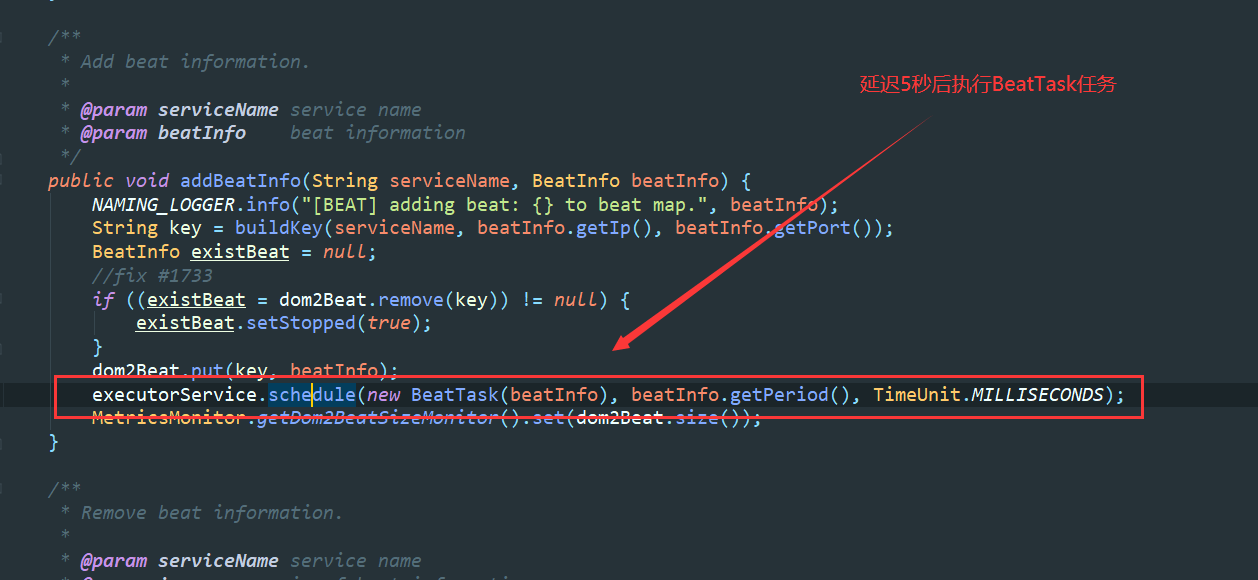1 客户端心跳机制
1.1 客户端注册源码流程
https://blog.csdn.net/qq_34125999/article/details/117566523
1.2 NacosNamingService
1.2.1 注册服务方法
@Override
public void registerInstance(String serviceName, String groupName, Instance instance) throws NacosException {
NamingUtils.checkInstanceIsLegal(instance);
//创建group@@servciceName
String groupedServiceName = NamingUtils.getGroupedName(serviceName, groupName);
//如果当前实例是临时实例(默认是临时实例)
if (instance.isEphemeral()) {
// 创建心跳信息
BeatInfo beatInfo = beatReactor.buildBeatInfo(groupedServiceName, instance);
//beanReactor添加心跳信息
beatReactor.addBeatInfo(groupedServiceName, beatInfo);
}
//发送请求向nacos注册服务
serverProxy.registerService(groupedServiceName, groupName, instance);
}
1.3 BeatReactor
1.3.1 buildBeatInfo
public BeatInfo buildBeatInfo(String groupedServiceName, Instance instance) {
//创建心跳对象
BeatInfo beatInfo = new BeatInfo();
//封装心跳信息
beatInfo.setServiceName(groupedServiceName);
beatInfo.setIp(instance.getIp());
beatInfo.setPort(instance.getPort());
beatInfo.setCluster(instance.getClusterName());
beatInfo.setWeight(instance.getWeight());
beatInfo.setMetadata(instance.getMetadata());
beatInfo.setScheduled(false);
/**
* 心跳间隔默认为5秒
*/
beatInfo.setPeriod(instance.getInstanceHeartBeatInterval());
return beatInfo;
}

1.3.2 addBeatInfo

1.3.3 BeatTask
描述: 查看 BeatTask 的run()方法。



1.3 服务端处理心跳
描述: 查看接口。


描述: 异步处理请求。


描述: 查看异步任务ClientBeatProcessor,run方法。
@Override
public void run() {
//找到当前服务
Service service = this.service;
if (Loggers.EVT_LOG.isDebugEnabled()) {
Loggers.EVT_LOG.debug("[CLIENT-BEAT] processing beat: {}", rsInfo.toString());
}
//获取相关信息
String ip = rsInfo.getIp();
String clusterName = rsInfo.getCluster();
int port = rsInfo.getPort();
Cluster cluster = service.getClusterMap().get(clusterName);
List<Instance> instances = cluster.allIPs(true);
//遍历找到注册心跳的服务
for (Instance instance : instances) {
//比对ip、port
if (instance.getIp().equals(ip) && instance.getPort() == port) {
if (Loggers.EVT_LOG.isDebugEnabled()) {
Loggers.EVT_LOG.debug("[CLIENT-BEAT] refresh beat: {}", rsInfo.toString());
}
/**
* 设置心跳
*/
instance.setLastBeat(System.currentTimeMillis());
//如果当前服务没被标记并且不健康,更新当前服务状态
if (!instance.isMarked()) {
if (!instance.isHealthy()) {
instance.setHealthy(true);
Loggers.EVT_LOG
.info("service: {} {POS} {IP-ENABLED} valid: {}:{}@{}, region: {}, msg: client beat ok",
cluster.getService().getName(), ip, port, cluster.getName(),
UtilsAndCommons.LOCALHOST_SITE);
getPushService().serviceChanged(service);
}
}
}
}
}
2 服务端健康检查
2.1 服务端注册nacos
https://blog.csdn.net/qq_34125999/article/details/117676950
2.2 Service
描述: 当服务注册时,会执行Service init方法,当前方法会异步开启注册服务健康监测。

2.3 HealthCheckReactor
描述: scheduleCheck方法,会异步提交ClientBeatCheckTask任务,延迟5秒后执行,并且每隔5秒执行。
public static void scheduleCheck(ClientBeatCheckTask task) {
futureMap.putIfAbsent(task.taskKey(), GlobalExecutor.scheduleNamingHealth(task, 5000, 5000, TimeUnit.MILLISECONDS));
}
2.4 ClientBeatCheckTask
描述: 查看异步执行任务 run方法。
@Override
public void run() {
try {
if (!getDistroMapper().responsible(service.getName())) {
return;
}
if (!getSwitchDomain().isHealthCheckEnabled()) {
return;
}
//获取服务所有Instance
List<Instance> instances = service.allIPs(true);
// first set health status of instances:
//第一次,遍历所有服务
for (Instance instance : instances) {
//如果当前时间减去服务上次注册时间大于15秒
if (System.currentTimeMillis() - instance.getLastBeat() > instance.getInstanceHeartBeatTimeOut()) {
//如果服务没被标记并且服务是健康的那么设置服务为非健康状态
if (!instance.isMarked()) {
if (instance.isHealthy()) {
instance.setHealthy(false);
Loggers.EVT_LOG
.info("{POS} {IP-DISABLED} valid: {}:{}@{}@{}, region: {}, msg: client timeout after {}, last beat: {}",
instance.getIp(), instance.getPort(), instance.getClusterName(),
service.getName(), UtilsAndCommons.LOCALHOST_SITE,
instance.getInstanceHeartBeatTimeOut(), instance.getLastBeat());
getPushService().serviceChanged(service);
ApplicationUtils.publishEvent(new InstanceHeartbeatTimeoutEvent(this, instance));
}
}
}
}
if (!getGlobalConfig().isExpireInstance()) {
return;
}
//第二次遍历所有服务
// then remove obsolete instances:
for (Instance instance : instances) {
if (instance.isMarked()) {
continue;
}
//如果当前时间减去服务上次心跳时间大于30秒,那么当前服务
if (System.currentTimeMillis() - instance.getLastBeat() > instance.getIpDeleteTimeout()) {
// delete instance
Loggers.SRV_LOG.info("[AUTO-DELETE-IP] service: {}, ip: {}", service.getName(),
JacksonUtils.toJson(instance));
//删除逻辑,调取nacos api进行服务删除【自己调自己】
deleteIp(instance);
}
}
} catch (Exception e) {
Loggers.SRV_LOG.warn("Exception while processing client beat time out.", e);
}
}
最后
以上就是沉默荷花最近收集整理的关于SpringCloud Nacos 心跳机制和服务健康检查源码解析1 客户端心跳机制2 服务端健康检查的全部内容,更多相关SpringCloud内容请搜索靠谱客的其他文章。
本图文内容来源于网友提供,作为学习参考使用,或来自网络收集整理,版权属于原作者所有。








发表评论 取消回复